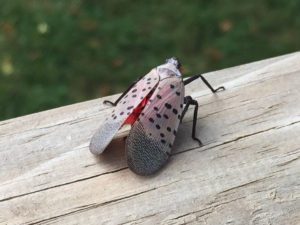What is a spotted lanternfly?

The spotted lanternfly, also known as lycorma delicatula, is a pesky planthopper that is native to China, India, and Vietnam. They were first spotted in the United States in 2014 in Berks County, Pennsylvania. When not in flight they are gray in color with black spots, however when they open their wings you can see red and black hind wings as well as a black and yellow abdomen.
Spotted lanternfly life cycle:
The spotted lanternfly takes less than a year to go from egg to full adult.
- Eggs hatch: Spotted lanternfly eggs look like masses of mud that have been smeared. These eggs begin to hatch in May all the way through June.
- Nymphs: Spotted lanternflies have four different nymph stages, which take place from June to July.
- Adult: Anywhere from June to December, spotted lanternflies are full-grown and begin looking for mates.
- Laying eggs: They mainly lay eggs at the end of the summer, but this can happen through December.
It’s important to note that adults do not survive through the winter, which is why it is important to eliminate the eggs when found!
How are spotted lanternflies harmful?
Spotted lanternflies damage various plants, such as fruit trees, grape vines, and various other hardwoods. These plants become weakened when the spotted lanternfly feeds on the sap of these plants and then discrete a mold that is harmful and that attracts other harmful insects.
How Mosquito Joe of Northern Delaware can help:
Mosquito Joe is dedicated to making outside fun again, which is why we offer spotted lanternfly control services. Our trained and certified Mosquito Joe technicians arrive at your property and apply a one-time treatment to the plants that these harmful spotted lantern flies are found on, eliminating them and preventing their spread to other plants.


